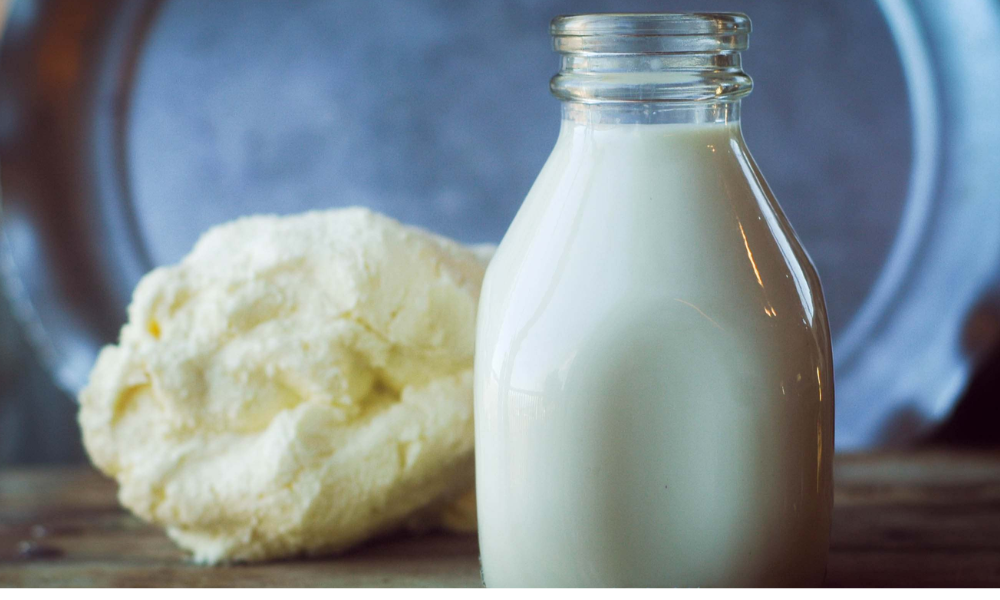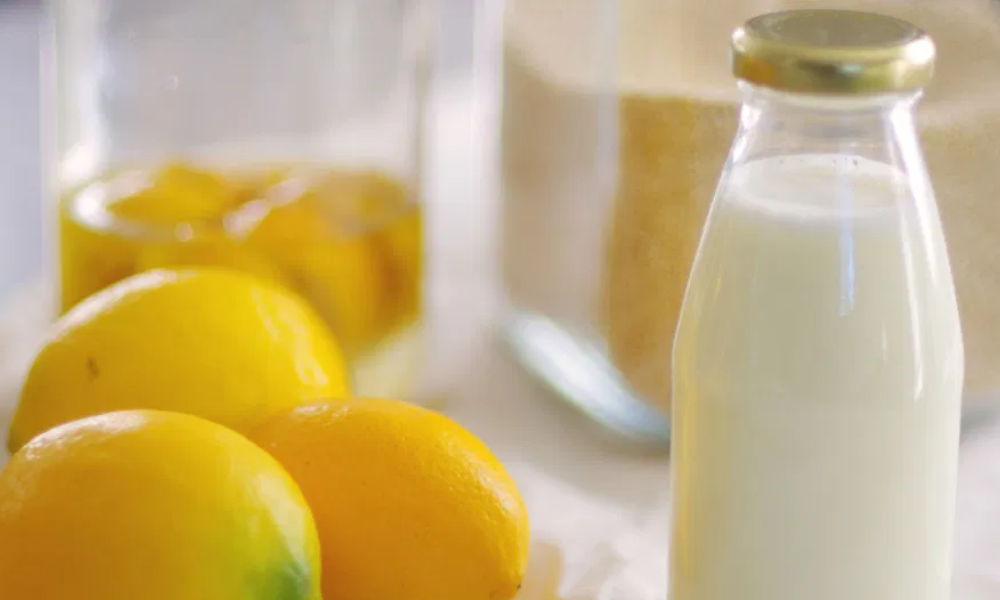Numerous recipes call for buttermilk. This acidic ingredient gives baked items a tart flavor. Baking soda needs to have an acid to be activated by buttermilk. Manufacture buttermilk; any milk can be used. You might also use vinegar or lemon juice as a replacement. To suit your recipe, you can change the acid concentration.
The most frequent application of buttermilk is in baking. When used with baking soda, it enhances the rise and fluffiness of foods like biscuits and pancakes. In addition, it’s frequently used to tenderize chicken before roasting or frying it, and it’s a crucial component in creamy sauces like ranch.
How to Make Buttermilk Out of Milk?
Cream of Tartar
Cream of tartar can be used to create a delicious alternative to buttermilk. This component is an acid in powder form that shares chemical properties with vinegar and lemon juice. In recipes for pancakes and other baked products, it can take the place of buttermilk. Additionally, it can be used to prepare meat marinades.
You can use one cup of milk and one teaspoon of cream of tartar to make buttermilk. In a liquid measuring cup, combine the milk and cream of tartar when ready to use. After that, stir the mixture frequently for five to ten minutes as it sits. In contrast to several buttermilk alternatives, it does not thicken or get overly watery.
Sour cream can be substituted with buttermilk. It gives baked goods a tangy flavor and helps gluten become more tender, giving them a softer texture and body. Quick loaves of bread also rise as a result. Buttermilk can also be produced using soy milk in addition to milk.
Lemon Juice
Lemon juice is a wonderful substitute for vinegar if you’re trying to produce buttermilk. One cup of milk and one tablespoon (15 mL) of lemon juice are all required. But it’s vital to remember that bottled lemon juice contains preservatives like sulfite. These compounds may harm some people, particularly those with asthma.
Lemon juice or distilled white vinegar is a few more well-liked alternatives. Because lemon juice contains the acid that converts milk to the buttermilk, it is a great option. Within ten minutes, the replacement ought to thicken. If you consume dairy or are a vegan allergy, lemon juice is also acceptable.
Lemon juice and coconut milk can also be swapped out in a 1:1 ratio. One cup of coconut milk should be combined with one tablespoon of lemon juice before being left at room temperature for at least 10 minutes. The milk should have thickened and appeared curdled after 10 minutes. Although it won’t be as thick as real buttermilk, this replacement will still be effective.
Apple Cider Vinegar
Apple cider vinegar is one of the first ingredients to make buttermilk. This acidic ingredient can be utilized in a variety of cooking methods. It will give meats a tangy flavor and aid in tenderization. You should be aware that malt vinegar should never be used in this recipe.
Apple cider vinegar and milk are the two ingredients needed to make buttermilk. Use a spoon to combine the two ingredients fully, then set aside for at least 10 minutes. Utilize the resultant buttermilk in your preferred baking recipes after that. You can substitute clear vinegar or freshly squeezed lemon juice if you lack apple cider vinegar.
Maintaining a normal cholesterol level is crucial because it lowers your risk of developing heart disease and stroke. Apple cider vinegar offers a wide range of health advantages. It can boost heart health and lower cholesterol and triglyceride levels. Additionally, it aids in maintaining a stable blood sugar level.
Cultured Kefir
Cultured kefir production is a rather simple procedure. You begin by adding a few tablespoons of kefir grains to two cups of milk and stirring thoroughly. About 12 hours should pass while the combination ferments. You can now stop the fermentation at this point. Or, if you want, let it continue to ferment. Kefir is now prepared for use or storage in the refrigerator.
After that, let the mixture sit for 18 to 24 hours in a warm location, like a refrigerator. It should have thickened and turned pleasantly sour by that point. It can be kept in the refrigerator or used in the same batch of buttermilk.
You can purchase the grains online or at a nearby farmer’s market if you want to make your kefir. Be sure to adhere to the directions on the packaging if you purchase something commercially. You will need one to two tablespoons of grains for each batch, but you can always keep some for later ones.
White Vinegar with Milk: Pour one tablespoon of white vinegar into a scant cup of whole or 2% milk. Stir and let it rest for 10 minutes at room temperature. The acid in the vinegar will gently curdle the milk.
Milk with Plain Yogurt: Stir milk into plain yogurt until it reaches buttermilk consistency (thickened milk). The amounts are roughly 34 cups of yogurt and 14 cups of milk, though they may change somewhat depending on how thick your yogurt is.
Milk and Sour Cream: Combine the two ingredients and whisk until the mixture has the consistency of buttermilk (thickened milk). Depending on your sour cream’s thickness, the measurements should be roughly 34 cups sour cream and 14 cup milk.
Does Tofu, Water, and Vinegar Substitute Buttermilk?
The majority of the substitutes for buttermilk we have suggested so far are simple to make and call for the use of either additional dairy products or plant-based dairy alternatives. According to Go Dairy Free, you may substitute for buttermilk by blending silken tofu (not the normal, denser tofu) with water, vinegar, lemon juice, and a little salt. While it necessitates a little more effort than other alternatives, this vegan buttermilk alternative produces a wonderful, creamy product that works well in many baking recipes.
Fourteen cups of silken tofu, 12 cup plus three teaspoons of water, one tablespoon of vinegar or lemon juice, and a dash of salt will all be combined in a blender. Then combine everything and mix until smooth. Before using, make sure to let the mixture sit for at least 10 minutes. Even though tofu is used in place of cheese in this recipe, baking soda still reacts with vinegar because of its acidity. Water alone only sometimes results in moist baked items with a little more body than tofu.
Is Buttermilk the Same as Sour Milk?
Two dairy products with a mildly sour and acidic flavor are buttermilk and sour milk. The primary distinction between buttermilk and sour milk is that the former is the liquid left over after the fat has been removed from the cream during butter production. In contrast, the latter is milk that has been acidified.
Can Buttermilk be Frozen in Ziploc Bags?
Give the buttermilk a thorough shake before doling out tablespoons of it into ice cube trays. Place the ice cubes in a ziplock freezer bag after they have frozen. Buttermilk will keep indefinitely if properly frozen, like all frozen foods, although it will taste best if consumed within three months.
Does Old Buttermilk Make you Sick?
You risk contracting food poisoning if you ingest buttermilk that has gone bad and was not stored at the proper 40°F temperatures. Due to the lactic acid that makes buttermilk sour, outdated buttermilk might make you sick. Expired buttermilk can also make you ill.
How does Buttermilk Benefit your Health?
Buttermilk is a great source of protein needed to develop strong muscles, skin, and bones. Most buttermilk sold today is now fortified with additional vitamins and minerals, like Vitamin A. vitamin D. Regular buttermilk consumption effectively lowers blood pressure, which benefits people with hypertension and heart disease. Additionally, buttermilk’s potassium lowers blood pressure. Our immune systems are boosted, and our bodies are shielded from infections when we regularly consume buttermilk.
Is Buttermilk Required to be Refrigerated?
Buttermilk must always be kept in the fridge. At or below 40°F (4.4°C), much like most dairy products. The area of your fridge door frequently seeing temperature changes is not a good place to store it. Keep buttermilk out of the sun and out of the room. It can be frozen in an airtight container for up to three months, either opened or unopened. It’s better to throw away your buttermilk if you detect any changes in how it looks or smells to prevent getting sick.
How can Buttermilk’s Shelf Life be Extended?
Take care when handling your buttermilk if you want to preserve it for as long as possible. Please don’t touch the bottle’s lip directly, keep your hands clean, and don’t drink from it. Buttermilk should be cooled below 40°F (4.4°C) for most dairy products to stop bacterial growth. Because the door of your refrigerator is most susceptible to temperature changes, avoid storing it there.
It would be best if you didn’t leave buttermilk out in the open at room temperature. After usage, put it back in the fridge as soon as possible to prevent it from getting into the danger zone between 40 and 140 degrees Fahrenheit (4.4 and 60 degrees Celsius), where bacteria growth quickens. Lastly, if you’re worried about food waste, buy the smallest size and use it before it expires.
Conclusion
To give baked goods a rich texture and depth of flavor, buttermilk is a vital ingredient. However, if you don’t generally buy it or have dietary restrictions, you can manufacture replacements at home with little effort. An acidic substance, usually lemon juice, vinegar, or cream of tartar, and a liquid, like dairy or plant-based milk, are the essential components of a buttermilk alternative. If you’re intrigued, try one of these possibilities the next time you’re baking.

